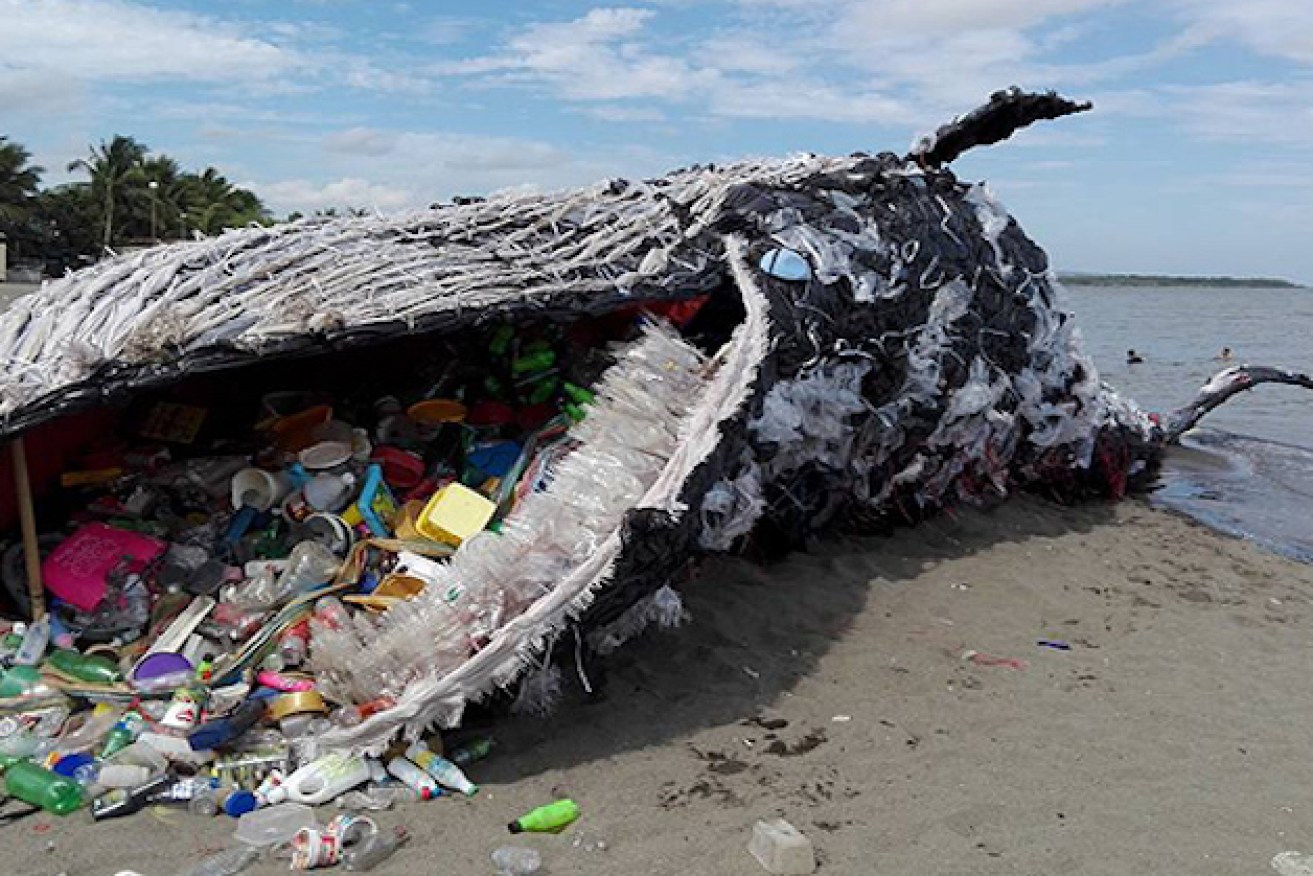Garry Linnell: Plastic is actually fantastic, we just need to recycle it properly


A whale constructed entirely from plastic waste. Photo: Getty
It was enough to get you humming a few bars of Kum Ba Yah and searching through the wardrobe for a pair of high-waisted flared pants and platform shoes.
The good old days returned last week, when more than 300,000 Australians around the country took to the streets to express their disgust over global warming and our increasingly polluted planet.
Would have loved to have been there. But my hands were covered in blood.
I’d just spent a few hours trying to prise open a gift enclosed in incredibly stiff plastic packaging.
You know the sort. No obvious openings. Heat-sealed. Impenetrable to sharp blades, oxy-acetylene blowtorches and even the sharp tongue of a mother-in-law.
Damn thing left my hands and fingers shredded and made me pine for those good old days when the world wasn’t choking in plastic and layers of complex packaging.
A world that included the Tien Wah Café.

Plastic has helped and hindered the planet. Photo: Getty
A Chinese takeaway joint, with a white dragon emblazoned across its front window, the Tien Wah Café was an exotic destination in the town in which I grew up, a once-every-few-months treat on a Saturday night.
The old man would head off in the Holden station wagon with a bunch of empty saucepans on the back seat.
He would return an hour or so later with an array of alluring and almost alien dishes; sweet and sour chicken in a rich, fatty batter, beef in an oily black bean sauce and enormous spring rolls the width and height of a telegraph pole, slathered in a sticky sweet red sauce.
We loved it. Of course, the dishes contained so much dehydrating MSG the family often spent the rest of the night attached to intravenous drips to prevent kidney failure.
But it was a small price to pay. And yes, for anyone under the age of 50, our takeaway containers were those saucepans.
That’s right.
There was a lot wrong with the world back in the late 1960s and early ‘70s – nuclear weapons were a real fear, the young and the innocent were dying in the Vietnam War and men were wearing pink velour shirts.
That world, however, hadn’t yet begun struggling for breath beneath a thick film of cling wrap.
We had Tupperware, which was expensive, while disposable picnic knives and forks were beginning to appear.
But plastic was not the ubiquitous item it is now, filling everything from our homes and cars to the bum cheeks and lips of Instagram models.
Our appetite for the stuff quickly became insatiable. Little wonder, too. Plastic only began being manufactured on an industrial scale in the early 1950s.
Within little more than a generation it transformed our lives, often for good.
You can sneer at its presence in our supermarkets, but plastic has given fresh food a much longer shelf life. You can ridicule multinational companies like Coca-Cola for producing more than 120 billion plastic bottles each year, but many of those containers also become the only portable form of water in the third world.

Plastic bottles have helped the third world. Photo: Getty
The medical breakthroughs, thanks to plastic instruments, are countless. Your car uses less fuel because plastic parts make it lighter. Same for planes and other heavy machinery.
But despite all the good it has accomplished – and let’s not be childish about this because plastic has been fantastic and undoubtedly saved millions of lives – many scientists are increasingly worrying about its adverse effects.
It’s a little like the good old days, when tobacco’s toxic by-products began showing up as tumours and doctors began sensing the link.
Half the plastic ever created has been produced in the past 15 years – much of it only used once before being discarded.
Eventually, millions of tonnes of it end up annually in that rapidly filling sink we call the ocean.
Scientists still have little idea how long it takes plastic to break up into its constituent molecules. Hundreds, perhaps thousands of years. In some cases, maybe never.
Instead, it breaks down into “microplastics” that are now found in every sea crevice and mountain peak on the planet, as well as in the lungs and bloodstreams of millions of creatures.
They are yet to be found in animal tissue, which is where so many potential problems could spring from.
But that is only because instruments to detect its presence are not yet advanced enough.
What sort of effect the additional chemicals added to plastic to give it flexibility and endurance remains unknown.
Yes, we have started taking steps – tiny ones – to reduce its presence, with token gestures like eradicating single-use supermarket plastic bags.
And we’re learning more about our grossly mismanaged recycling industry and how much of the refuse from our yellow bins ends up in landfill.
In fact, it’s reached the point where the only material genuinely being recycled with certainty these days are the rhythms, beats and lyrics of 1970s songs that are now being “sampled” by half the modern artists in the Top 40.
The reality is that almost half of the world’s plastic waste is being produced by just five nations – China, the Philippines, Vietnam, Sri Lanka and Indonesia.

Our recycling industry is grossly mismanaged. Photo: Getty
Most of these countries, their waterways and beaches clogged with refuse, are now declining to take our garbage.
And given the spineless measures taken at state and federal government level to construct a meaningful recycling industry, we are now left with a mountain of our own plastic destined for landfills around the country.
It’s a bleak outlook. Perhaps the only positive is that in 1000 years’ time, archaeologists of the future peering into vast pits of plastic bottles will at least know we were the most hydrated society in history.
But for now we are left with largely symbolic measures. Saucepans for takeaway, anyone?








